Taxation Law Assignment: Australian Taxation and Legal Framework
VerifiedAdded on 2023/01/06
|9
|2582
|66
Homework Assignment
AI Summary
This taxation law assignment provides a detailed analysis of various aspects of Australian taxation law. The assignment begins with an examination of tax liability for a non-resident earning salary in Australia, followed by an analysis of a court case concerning the sale of land and its tax implications. It then explores the Goods and Services Tax (GST) consequences for companies, including scenarios involving returned goods. Further, the assignment includes the calculation of tax liability for an organization, considering various income sources and deductions. A discussion of the ATO's Test Case Litigation Program is also provided. The assignment concludes with the calculation of net income and allocation of income for a firm, along with a reference to the relevant legislation, specifically the Partnership Law 1895. This comprehensive analysis is designed to provide a thorough understanding of Australian taxation principles and their practical application.
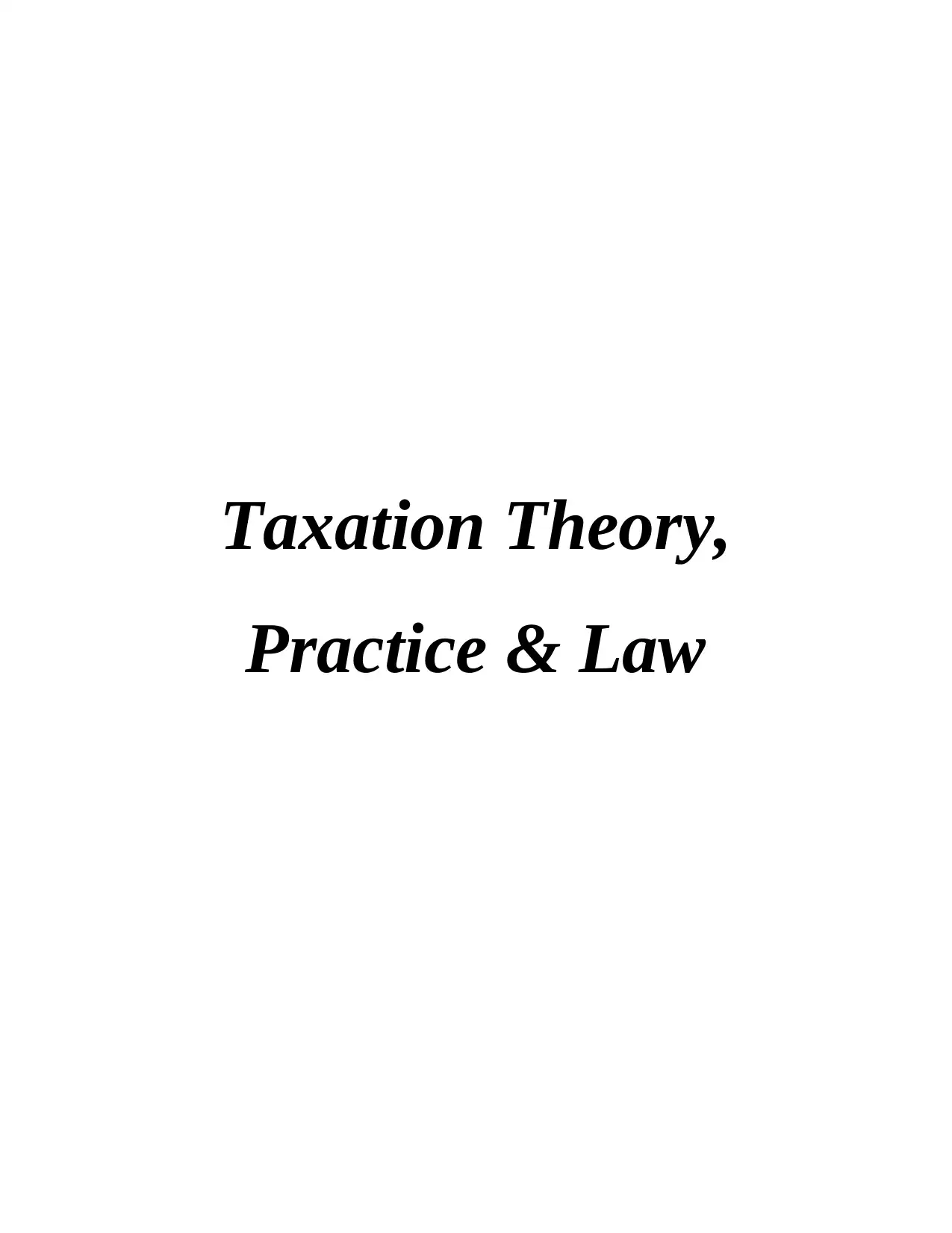
Taxation Theory,
Practice & Law
Practice & Law
Paraphrase This Document
Need a fresh take? Get an instant paraphrase of this document with our AI Paraphraser
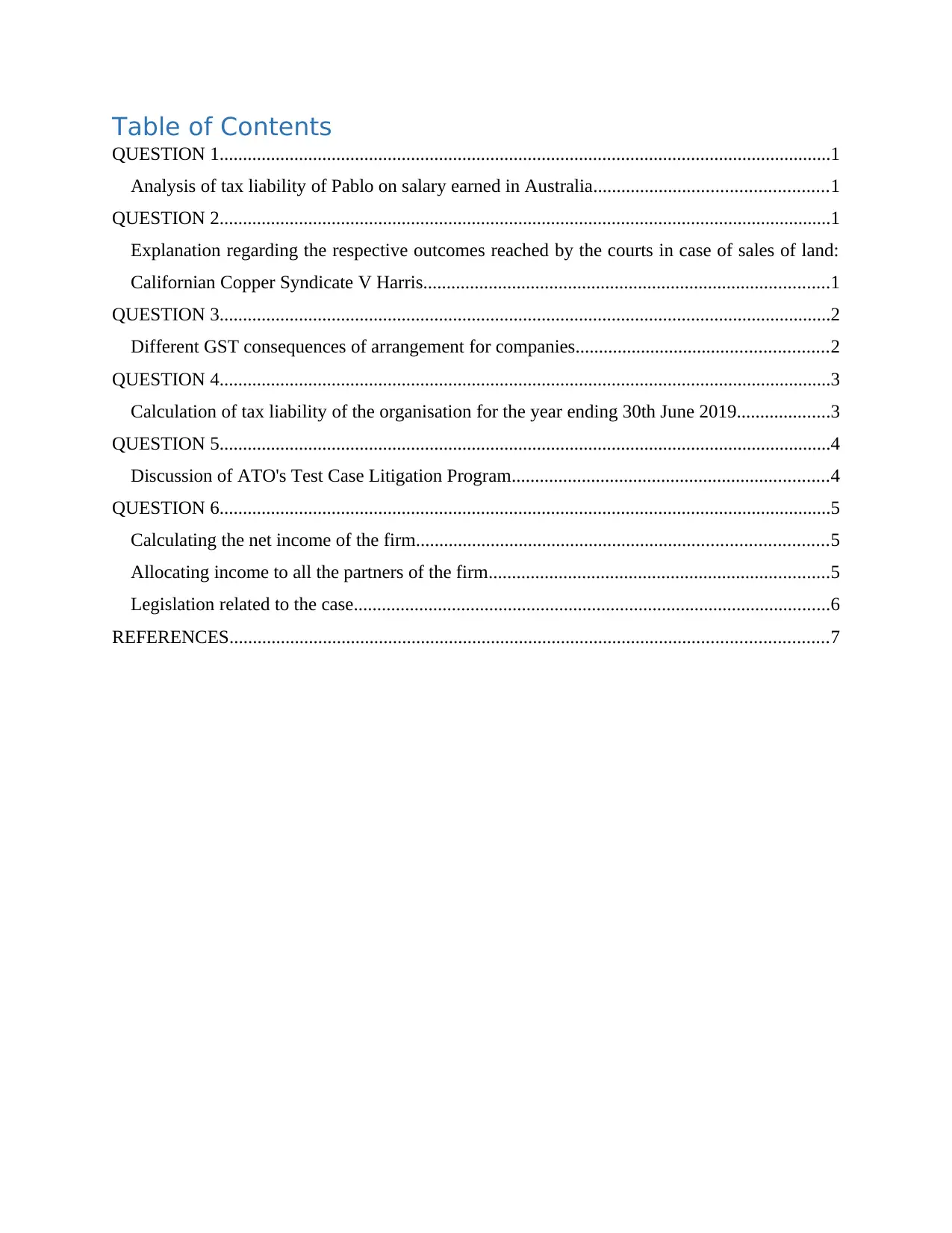
Table of Contents
QUESTION 1...................................................................................................................................1
Analysis of tax liability of Pablo on salary earned in Australia..................................................1
QUESTION 2...................................................................................................................................1
Explanation regarding the respective outcomes reached by the courts in case of sales of land:
Californian Copper Syndicate V Harris.......................................................................................1
QUESTION 3...................................................................................................................................2
Different GST consequences of arrangement for companies......................................................2
QUESTION 4...................................................................................................................................3
Calculation of tax liability of the organisation for the year ending 30th June 2019....................3
QUESTION 5...................................................................................................................................4
Discussion of ATO's Test Case Litigation Program....................................................................4
QUESTION 6...................................................................................................................................5
Calculating the net income of the firm........................................................................................5
Allocating income to all the partners of the firm.........................................................................5
Legislation related to the case......................................................................................................6
REFERENCES................................................................................................................................7
QUESTION 1...................................................................................................................................1
Analysis of tax liability of Pablo on salary earned in Australia..................................................1
QUESTION 2...................................................................................................................................1
Explanation regarding the respective outcomes reached by the courts in case of sales of land:
Californian Copper Syndicate V Harris.......................................................................................1
QUESTION 3...................................................................................................................................2
Different GST consequences of arrangement for companies......................................................2
QUESTION 4...................................................................................................................................3
Calculation of tax liability of the organisation for the year ending 30th June 2019....................3
QUESTION 5...................................................................................................................................4
Discussion of ATO's Test Case Litigation Program....................................................................4
QUESTION 6...................................................................................................................................5
Calculating the net income of the firm........................................................................................5
Allocating income to all the partners of the firm.........................................................................5
Legislation related to the case......................................................................................................6
REFERENCES................................................................................................................................7
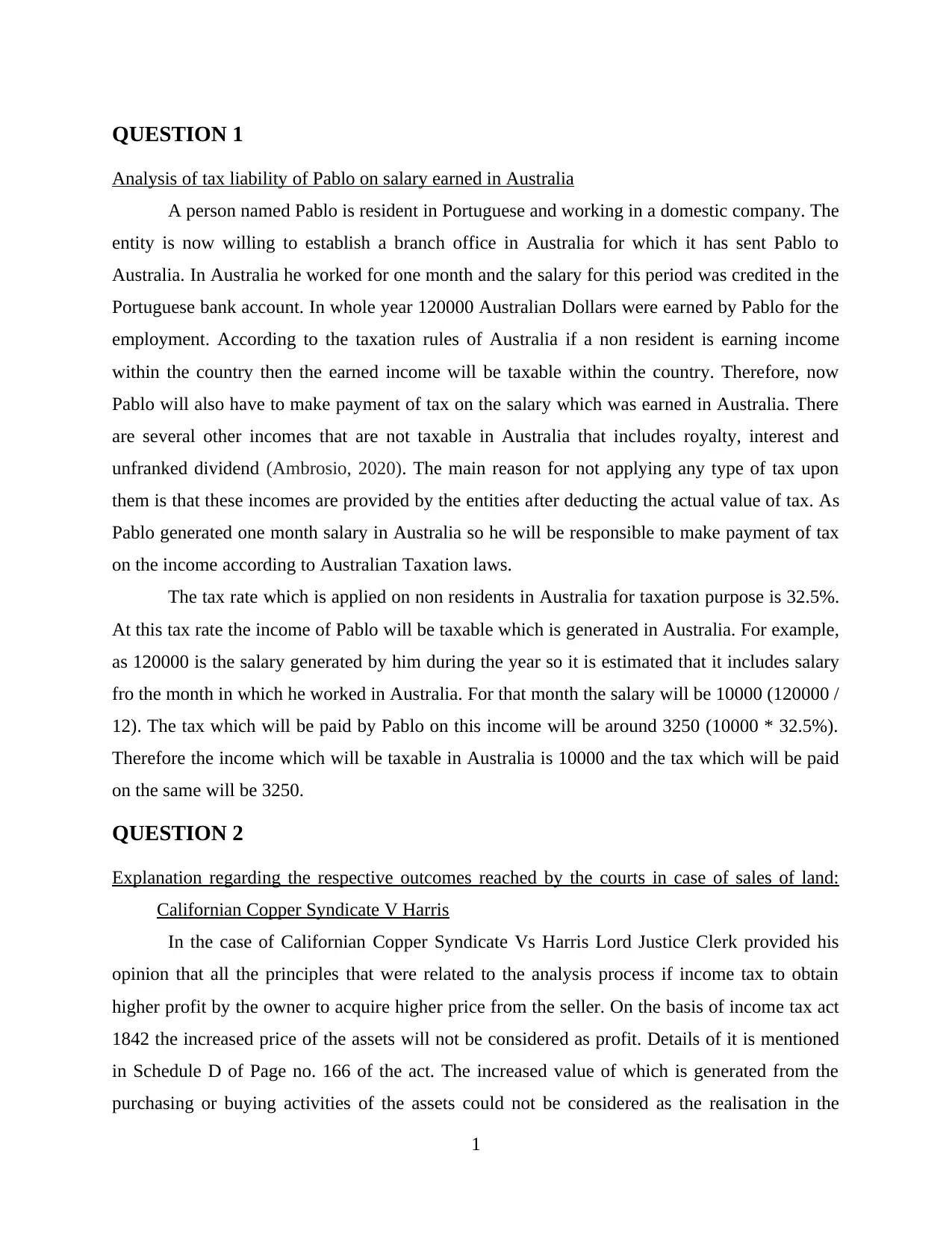
QUESTION 1
Analysis of tax liability of Pablo on salary earned in Australia
A person named Pablo is resident in Portuguese and working in a domestic company. The
entity is now willing to establish a branch office in Australia for which it has sent Pablo to
Australia. In Australia he worked for one month and the salary for this period was credited in the
Portuguese bank account. In whole year 120000 Australian Dollars were earned by Pablo for the
employment. According to the taxation rules of Australia if a non resident is earning income
within the country then the earned income will be taxable within the country. Therefore, now
Pablo will also have to make payment of tax on the salary which was earned in Australia. There
are several other incomes that are not taxable in Australia that includes royalty, interest and
unfranked dividend (Ambrosio, 2020). The main reason for not applying any type of tax upon
them is that these incomes are provided by the entities after deducting the actual value of tax. As
Pablo generated one month salary in Australia so he will be responsible to make payment of tax
on the income according to Australian Taxation laws.
The tax rate which is applied on non residents in Australia for taxation purpose is 32.5%.
At this tax rate the income of Pablo will be taxable which is generated in Australia. For example,
as 120000 is the salary generated by him during the year so it is estimated that it includes salary
fro the month in which he worked in Australia. For that month the salary will be 10000 (120000 /
12). The tax which will be paid by Pablo on this income will be around 3250 (10000 * 32.5%).
Therefore the income which will be taxable in Australia is 10000 and the tax which will be paid
on the same will be 3250.
QUESTION 2
Explanation regarding the respective outcomes reached by the courts in case of sales of land:
Californian Copper Syndicate V Harris
In the case of Californian Copper Syndicate Vs Harris Lord Justice Clerk provided his
opinion that all the principles that were related to the analysis process if income tax to obtain
higher profit by the owner to acquire higher price from the seller. On the basis of income tax act
1842 the increased price of the assets will not be considered as profit. Details of it is mentioned
in Schedule D of Page no. 166 of the act. The increased value of which is generated from the
purchasing or buying activities of the assets could not be considered as the realisation in the
1
Analysis of tax liability of Pablo on salary earned in Australia
A person named Pablo is resident in Portuguese and working in a domestic company. The
entity is now willing to establish a branch office in Australia for which it has sent Pablo to
Australia. In Australia he worked for one month and the salary for this period was credited in the
Portuguese bank account. In whole year 120000 Australian Dollars were earned by Pablo for the
employment. According to the taxation rules of Australia if a non resident is earning income
within the country then the earned income will be taxable within the country. Therefore, now
Pablo will also have to make payment of tax on the salary which was earned in Australia. There
are several other incomes that are not taxable in Australia that includes royalty, interest and
unfranked dividend (Ambrosio, 2020). The main reason for not applying any type of tax upon
them is that these incomes are provided by the entities after deducting the actual value of tax. As
Pablo generated one month salary in Australia so he will be responsible to make payment of tax
on the income according to Australian Taxation laws.
The tax rate which is applied on non residents in Australia for taxation purpose is 32.5%.
At this tax rate the income of Pablo will be taxable which is generated in Australia. For example,
as 120000 is the salary generated by him during the year so it is estimated that it includes salary
fro the month in which he worked in Australia. For that month the salary will be 10000 (120000 /
12). The tax which will be paid by Pablo on this income will be around 3250 (10000 * 32.5%).
Therefore the income which will be taxable in Australia is 10000 and the tax which will be paid
on the same will be 3250.
QUESTION 2
Explanation regarding the respective outcomes reached by the courts in case of sales of land:
Californian Copper Syndicate V Harris
In the case of Californian Copper Syndicate Vs Harris Lord Justice Clerk provided his
opinion that all the principles that were related to the analysis process if income tax to obtain
higher profit by the owner to acquire higher price from the seller. On the basis of income tax act
1842 the increased price of the assets will not be considered as profit. Details of it is mentioned
in Schedule D of Page no. 166 of the act. The increased value of which is generated from the
purchasing or buying activities of the assets could not be considered as the realisation in the
1
⊘ This is a preview!⊘
Do you want full access?
Subscribe today to unlock all pages.

Trusted by 1+ million students worldwide
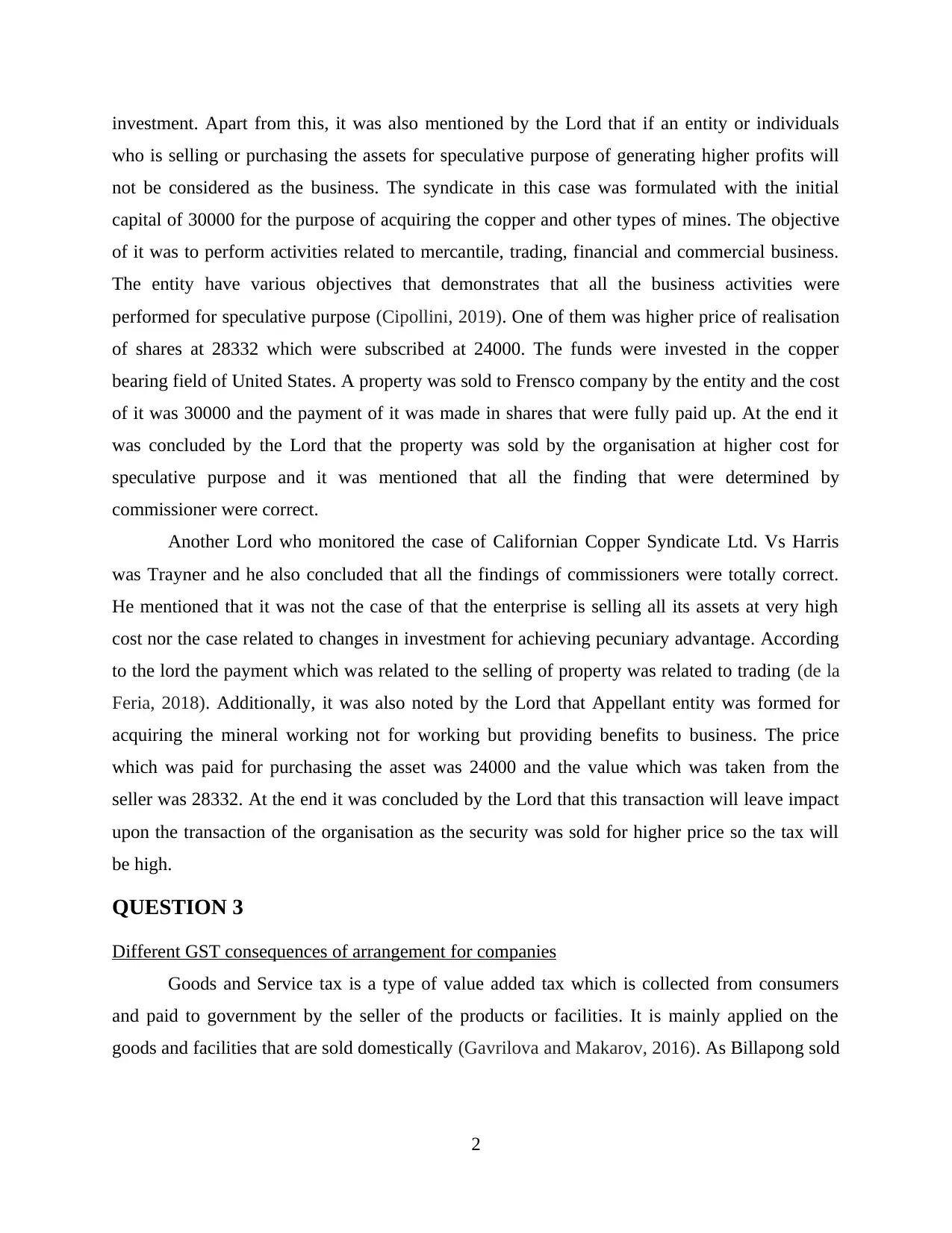
investment. Apart from this, it was also mentioned by the Lord that if an entity or individuals
who is selling or purchasing the assets for speculative purpose of generating higher profits will
not be considered as the business. The syndicate in this case was formulated with the initial
capital of 30000 for the purpose of acquiring the copper and other types of mines. The objective
of it was to perform activities related to mercantile, trading, financial and commercial business.
The entity have various objectives that demonstrates that all the business activities were
performed for speculative purpose (Cipollini, 2019). One of them was higher price of realisation
of shares at 28332 which were subscribed at 24000. The funds were invested in the copper
bearing field of United States. A property was sold to Frensco company by the entity and the cost
of it was 30000 and the payment of it was made in shares that were fully paid up. At the end it
was concluded by the Lord that the property was sold by the organisation at higher cost for
speculative purpose and it was mentioned that all the finding that were determined by
commissioner were correct.
Another Lord who monitored the case of Californian Copper Syndicate Ltd. Vs Harris
was Trayner and he also concluded that all the findings of commissioners were totally correct.
He mentioned that it was not the case of that the enterprise is selling all its assets at very high
cost nor the case related to changes in investment for achieving pecuniary advantage. According
to the lord the payment which was related to the selling of property was related to trading (de la
Feria, 2018). Additionally, it was also noted by the Lord that Appellant entity was formed for
acquiring the mineral working not for working but providing benefits to business. The price
which was paid for purchasing the asset was 24000 and the value which was taken from the
seller was 28332. At the end it was concluded by the Lord that this transaction will leave impact
upon the transaction of the organisation as the security was sold for higher price so the tax will
be high.
QUESTION 3
Different GST consequences of arrangement for companies
Goods and Service tax is a type of value added tax which is collected from consumers
and paid to government by the seller of the products or facilities. It is mainly applied on the
goods and facilities that are sold domestically (Gavrilova and Makarov, 2016). As Billapong sold
2
who is selling or purchasing the assets for speculative purpose of generating higher profits will
not be considered as the business. The syndicate in this case was formulated with the initial
capital of 30000 for the purpose of acquiring the copper and other types of mines. The objective
of it was to perform activities related to mercantile, trading, financial and commercial business.
The entity have various objectives that demonstrates that all the business activities were
performed for speculative purpose (Cipollini, 2019). One of them was higher price of realisation
of shares at 28332 which were subscribed at 24000. The funds were invested in the copper
bearing field of United States. A property was sold to Frensco company by the entity and the cost
of it was 30000 and the payment of it was made in shares that were fully paid up. At the end it
was concluded by the Lord that the property was sold by the organisation at higher cost for
speculative purpose and it was mentioned that all the finding that were determined by
commissioner were correct.
Another Lord who monitored the case of Californian Copper Syndicate Ltd. Vs Harris
was Trayner and he also concluded that all the findings of commissioners were totally correct.
He mentioned that it was not the case of that the enterprise is selling all its assets at very high
cost nor the case related to changes in investment for achieving pecuniary advantage. According
to the lord the payment which was related to the selling of property was related to trading (de la
Feria, 2018). Additionally, it was also noted by the Lord that Appellant entity was formed for
acquiring the mineral working not for working but providing benefits to business. The price
which was paid for purchasing the asset was 24000 and the value which was taken from the
seller was 28332. At the end it was concluded by the Lord that this transaction will leave impact
upon the transaction of the organisation as the security was sold for higher price so the tax will
be high.
QUESTION 3
Different GST consequences of arrangement for companies
Goods and Service tax is a type of value added tax which is collected from consumers
and paid to government by the seller of the products or facilities. It is mainly applied on the
goods and facilities that are sold domestically (Gavrilova and Makarov, 2016). As Billapong sold
2
Paraphrase This Document
Need a fresh take? Get an instant paraphrase of this document with our AI Paraphraser
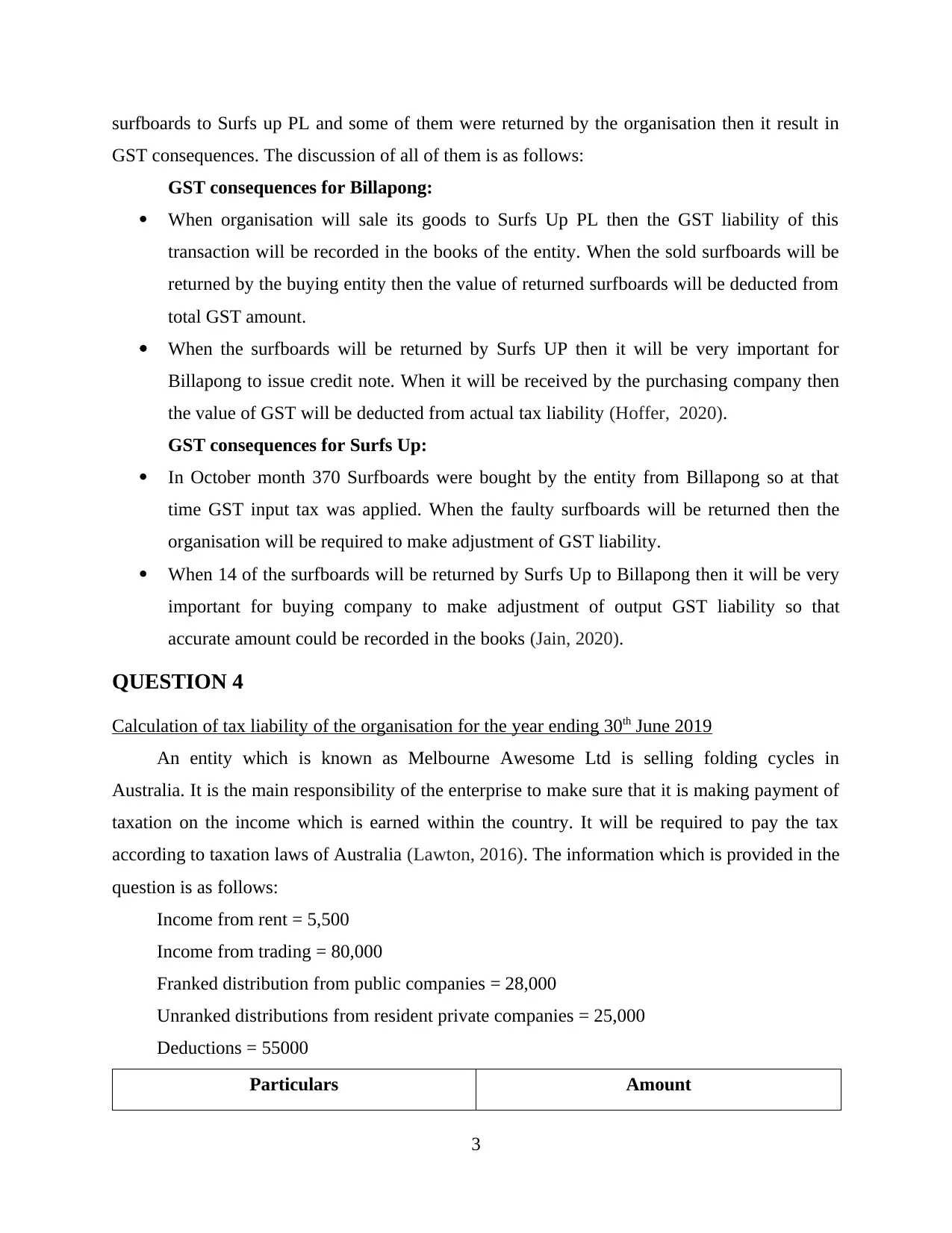
surfboards to Surfs up PL and some of them were returned by the organisation then it result in
GST consequences. The discussion of all of them is as follows:
GST consequences for Billapong:
When organisation will sale its goods to Surfs Up PL then the GST liability of this
transaction will be recorded in the books of the entity. When the sold surfboards will be
returned by the buying entity then the value of returned surfboards will be deducted from
total GST amount.
When the surfboards will be returned by Surfs UP then it will be very important for
Billapong to issue credit note. When it will be received by the purchasing company then
the value of GST will be deducted from actual tax liability (Hoffer, 2020).
GST consequences for Surfs Up:
In October month 370 Surfboards were bought by the entity from Billapong so at that
time GST input tax was applied. When the faulty surfboards will be returned then the
organisation will be required to make adjustment of GST liability.
When 14 of the surfboards will be returned by Surfs Up to Billapong then it will be very
important for buying company to make adjustment of output GST liability so that
accurate amount could be recorded in the books (Jain, 2020).
QUESTION 4
Calculation of tax liability of the organisation for the year ending 30th June 2019
An entity which is known as Melbourne Awesome Ltd is selling folding cycles in
Australia. It is the main responsibility of the enterprise to make sure that it is making payment of
taxation on the income which is earned within the country. It will be required to pay the tax
according to taxation laws of Australia (Lawton, 2016). The information which is provided in the
question is as follows:
Income from rent = 5,500
Income from trading = 80,000
Franked distribution from public companies = 28,000
Unranked distributions from resident private companies = 25,000
Deductions = 55000
Particulars Amount
3
GST consequences. The discussion of all of them is as follows:
GST consequences for Billapong:
When organisation will sale its goods to Surfs Up PL then the GST liability of this
transaction will be recorded in the books of the entity. When the sold surfboards will be
returned by the buying entity then the value of returned surfboards will be deducted from
total GST amount.
When the surfboards will be returned by Surfs UP then it will be very important for
Billapong to issue credit note. When it will be received by the purchasing company then
the value of GST will be deducted from actual tax liability (Hoffer, 2020).
GST consequences for Surfs Up:
In October month 370 Surfboards were bought by the entity from Billapong so at that
time GST input tax was applied. When the faulty surfboards will be returned then the
organisation will be required to make adjustment of GST liability.
When 14 of the surfboards will be returned by Surfs Up to Billapong then it will be very
important for buying company to make adjustment of output GST liability so that
accurate amount could be recorded in the books (Jain, 2020).
QUESTION 4
Calculation of tax liability of the organisation for the year ending 30th June 2019
An entity which is known as Melbourne Awesome Ltd is selling folding cycles in
Australia. It is the main responsibility of the enterprise to make sure that it is making payment of
taxation on the income which is earned within the country. It will be required to pay the tax
according to taxation laws of Australia (Lawton, 2016). The information which is provided in the
question is as follows:
Income from rent = 5,500
Income from trading = 80,000
Franked distribution from public companies = 28,000
Unranked distributions from resident private companies = 25,000
Deductions = 55000
Particulars Amount
3
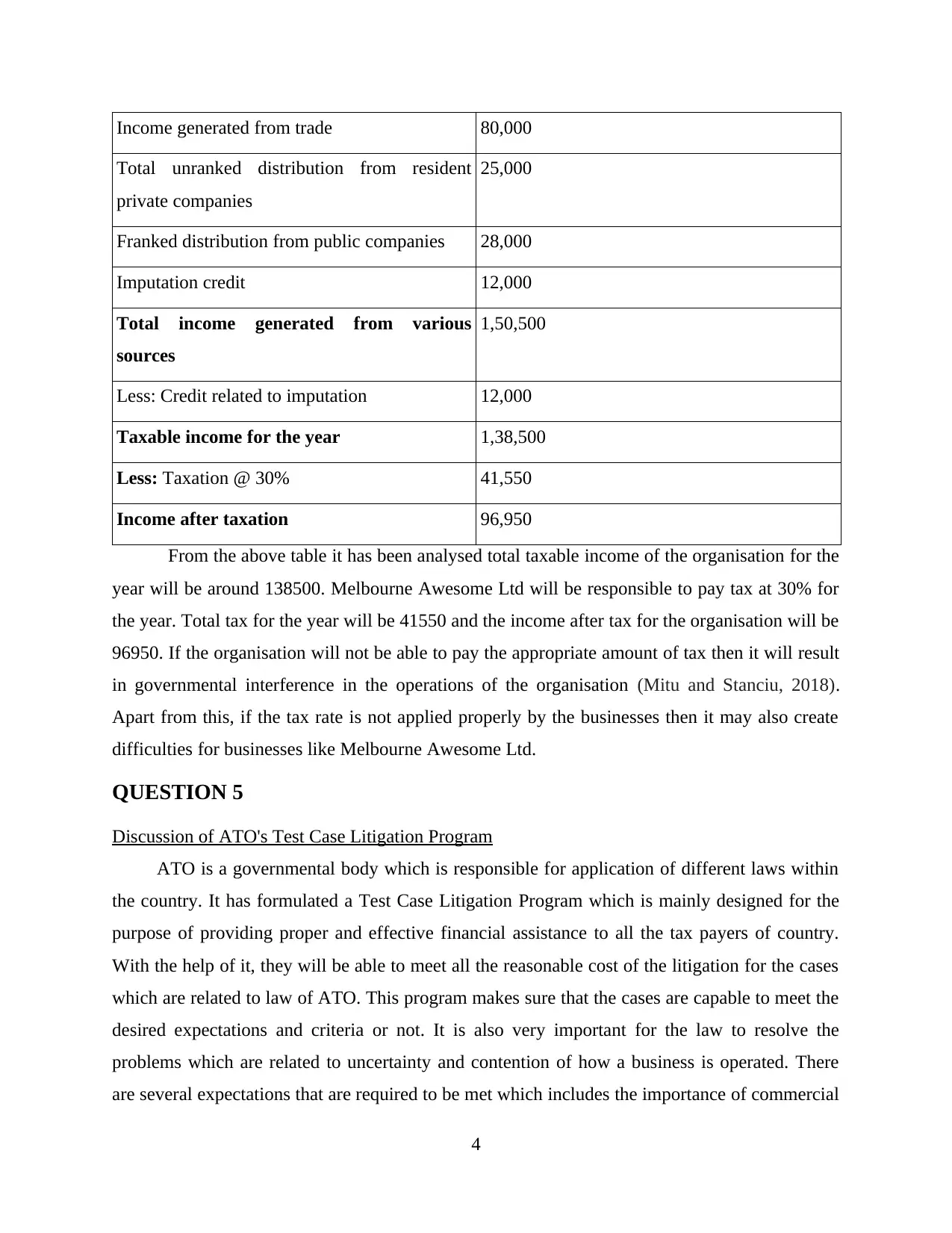
Income generated from trade 80,000
Total unranked distribution from resident
private companies
25,000
Franked distribution from public companies 28,000
Imputation credit 12,000
Total income generated from various
sources
1,50,500
Less: Credit related to imputation 12,000
Taxable income for the year 1,38,500
Less: Taxation @ 30% 41,550
Income after taxation 96,950
From the above table it has been analysed total taxable income of the organisation for the
year will be around 138500. Melbourne Awesome Ltd will be responsible to pay tax at 30% for
the year. Total tax for the year will be 41550 and the income after tax for the organisation will be
96950. If the organisation will not be able to pay the appropriate amount of tax then it will result
in governmental interference in the operations of the organisation (Mitu and Stanciu, 2018).
Apart from this, if the tax rate is not applied properly by the businesses then it may also create
difficulties for businesses like Melbourne Awesome Ltd.
QUESTION 5
Discussion of ATO's Test Case Litigation Program
ATO is a governmental body which is responsible for application of different laws within
the country. It has formulated a Test Case Litigation Program which is mainly designed for the
purpose of providing proper and effective financial assistance to all the tax payers of country.
With the help of it, they will be able to meet all the reasonable cost of the litigation for the cases
which are related to law of ATO. This program makes sure that the cases are capable to meet the
desired expectations and criteria or not. It is also very important for the law to resolve the
problems which are related to uncertainty and contention of how a business is operated. There
are several expectations that are required to be met which includes the importance of commercial
4
Total unranked distribution from resident
private companies
25,000
Franked distribution from public companies 28,000
Imputation credit 12,000
Total income generated from various
sources
1,50,500
Less: Credit related to imputation 12,000
Taxable income for the year 1,38,500
Less: Taxation @ 30% 41,550
Income after taxation 96,950
From the above table it has been analysed total taxable income of the organisation for the
year will be around 138500. Melbourne Awesome Ltd will be responsible to pay tax at 30% for
the year. Total tax for the year will be 41550 and the income after tax for the organisation will be
96950. If the organisation will not be able to pay the appropriate amount of tax then it will result
in governmental interference in the operations of the organisation (Mitu and Stanciu, 2018).
Apart from this, if the tax rate is not applied properly by the businesses then it may also create
difficulties for businesses like Melbourne Awesome Ltd.
QUESTION 5
Discussion of ATO's Test Case Litigation Program
ATO is a governmental body which is responsible for application of different laws within
the country. It has formulated a Test Case Litigation Program which is mainly designed for the
purpose of providing proper and effective financial assistance to all the tax payers of country.
With the help of it, they will be able to meet all the reasonable cost of the litigation for the cases
which are related to law of ATO. This program makes sure that the cases are capable to meet the
desired expectations and criteria or not. It is also very important for the law to resolve the
problems which are related to uncertainty and contention of how a business is operated. There
are several expectations that are required to be met which includes the importance of commercial
4
⊘ This is a preview!⊘
Do you want full access?
Subscribe today to unlock all pages.

Trusted by 1+ million students worldwide
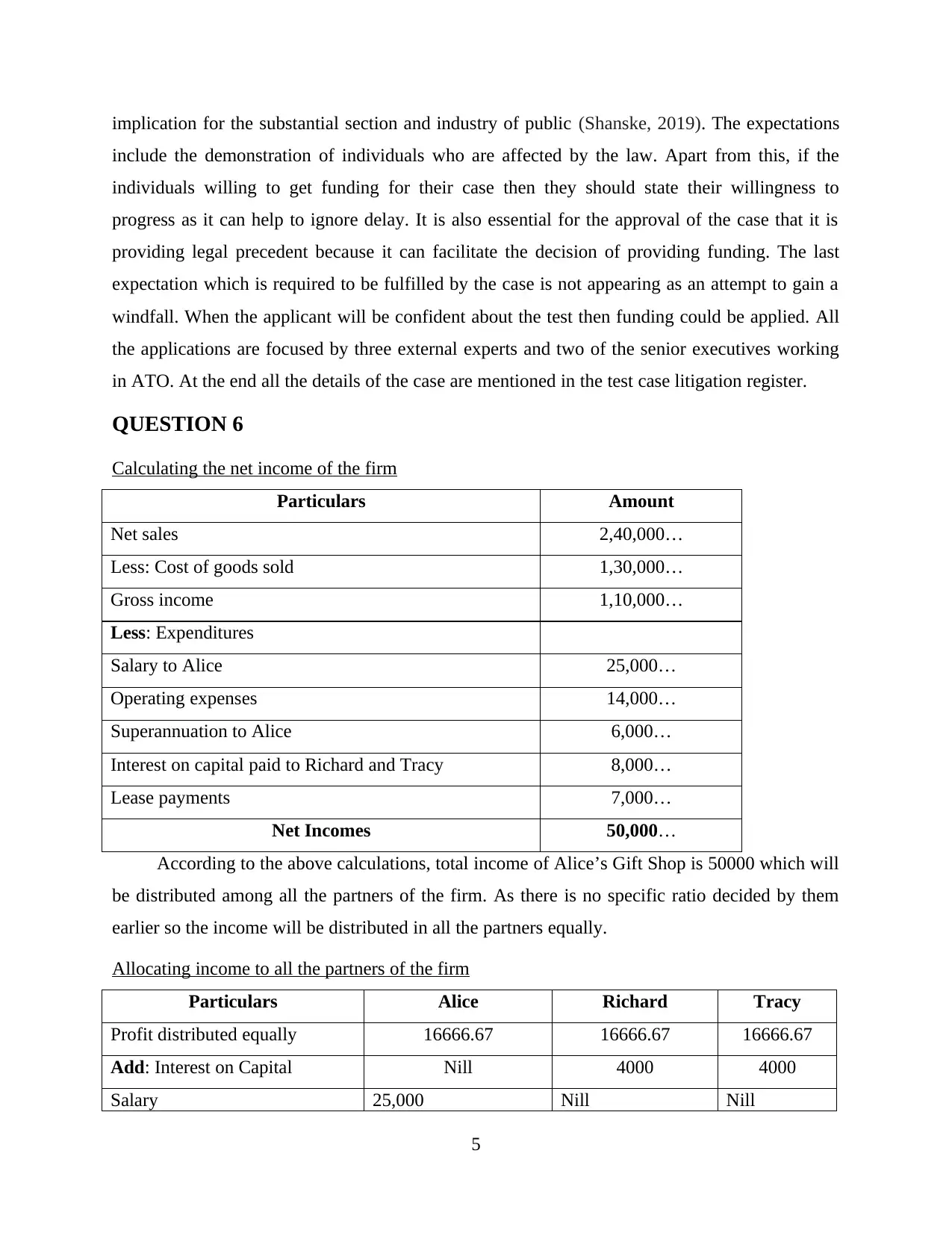
implication for the substantial section and industry of public (Shanske, 2019). The expectations
include the demonstration of individuals who are affected by the law. Apart from this, if the
individuals willing to get funding for their case then they should state their willingness to
progress as it can help to ignore delay. It is also essential for the approval of the case that it is
providing legal precedent because it can facilitate the decision of providing funding. The last
expectation which is required to be fulfilled by the case is not appearing as an attempt to gain a
windfall. When the applicant will be confident about the test then funding could be applied. All
the applications are focused by three external experts and two of the senior executives working
in ATO. At the end all the details of the case are mentioned in the test case litigation register.
QUESTION 6
Calculating the net income of the firm
Particulars Amount
Net sales 2,40,000…
Less: Cost of goods sold 1,30,000…
Gross income 1,10,000…
Less: Expenditures
Salary to Alice 25,000…
Operating expenses 14,000…
Superannuation to Alice 6,000…
Interest on capital paid to Richard and Tracy 8,000…
Lease payments 7,000…
Net Incomes 50,000…
According to the above calculations, total income of Alice’s Gift Shop is 50000 which will
be distributed among all the partners of the firm. As there is no specific ratio decided by them
earlier so the income will be distributed in all the partners equally.
Allocating income to all the partners of the firm
Particulars Alice Richard Tracy
Profit distributed equally 16666.67 16666.67 16666.67
Add: Interest on Capital Nill 4000 4000
Salary 25,000 Nill Nill
5
include the demonstration of individuals who are affected by the law. Apart from this, if the
individuals willing to get funding for their case then they should state their willingness to
progress as it can help to ignore delay. It is also essential for the approval of the case that it is
providing legal precedent because it can facilitate the decision of providing funding. The last
expectation which is required to be fulfilled by the case is not appearing as an attempt to gain a
windfall. When the applicant will be confident about the test then funding could be applied. All
the applications are focused by three external experts and two of the senior executives working
in ATO. At the end all the details of the case are mentioned in the test case litigation register.
QUESTION 6
Calculating the net income of the firm
Particulars Amount
Net sales 2,40,000…
Less: Cost of goods sold 1,30,000…
Gross income 1,10,000…
Less: Expenditures
Salary to Alice 25,000…
Operating expenses 14,000…
Superannuation to Alice 6,000…
Interest on capital paid to Richard and Tracy 8,000…
Lease payments 7,000…
Net Incomes 50,000…
According to the above calculations, total income of Alice’s Gift Shop is 50000 which will
be distributed among all the partners of the firm. As there is no specific ratio decided by them
earlier so the income will be distributed in all the partners equally.
Allocating income to all the partners of the firm
Particulars Alice Richard Tracy
Profit distributed equally 16666.67 16666.67 16666.67
Add: Interest on Capital Nill 4000 4000
Salary 25,000 Nill Nill
5
Paraphrase This Document
Need a fresh take? Get an instant paraphrase of this document with our AI Paraphraser
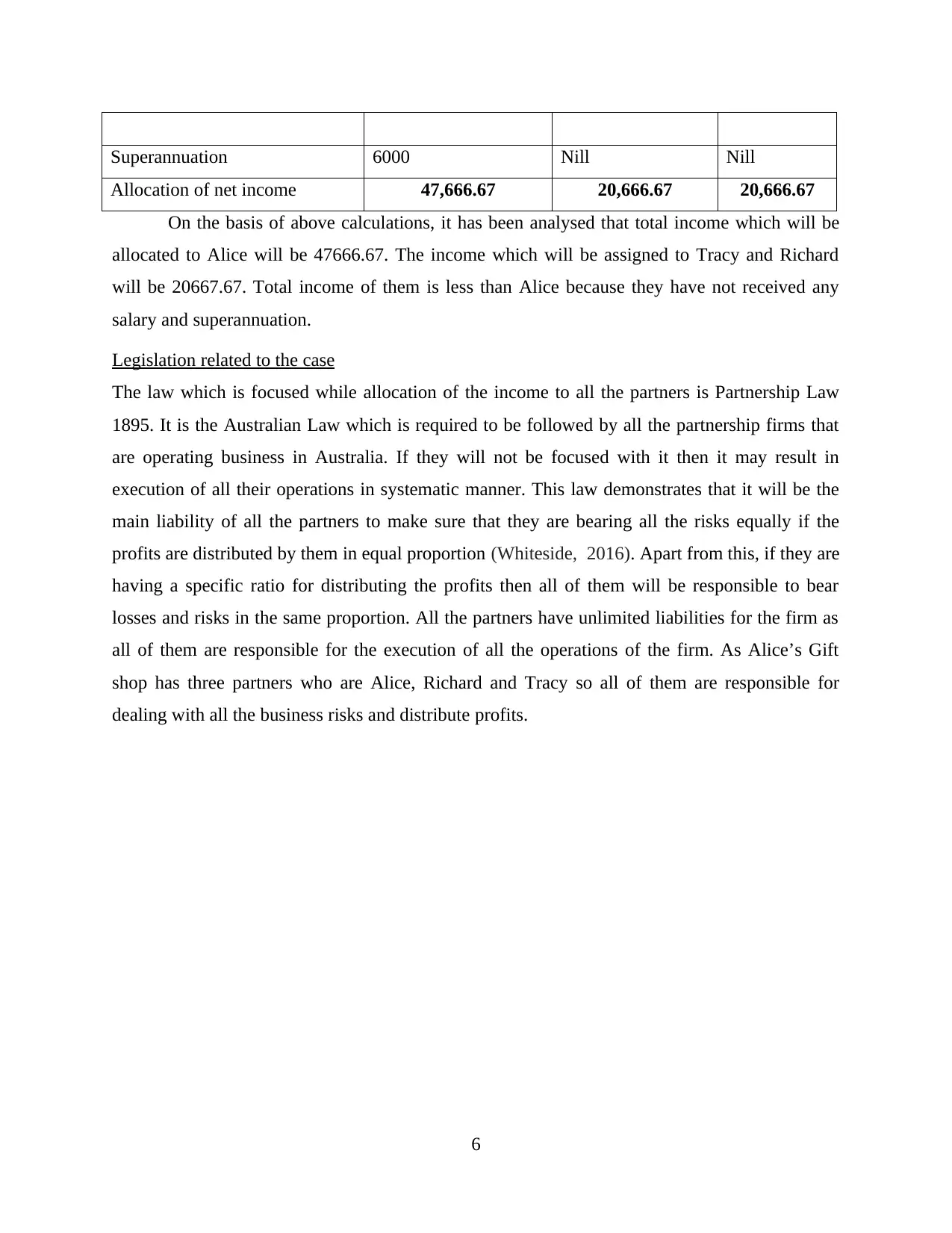
Superannuation 6000 Nill Nill
Allocation of net income 47,666.67 20,666.67 20,666.67
On the basis of above calculations, it has been analysed that total income which will be
allocated to Alice will be 47666.67. The income which will be assigned to Tracy and Richard
will be 20667.67. Total income of them is less than Alice because they have not received any
salary and superannuation.
Legislation related to the case
The law which is focused while allocation of the income to all the partners is Partnership Law
1895. It is the Australian Law which is required to be followed by all the partnership firms that
are operating business in Australia. If they will not be focused with it then it may result in
execution of all their operations in systematic manner. This law demonstrates that it will be the
main liability of all the partners to make sure that they are bearing all the risks equally if the
profits are distributed by them in equal proportion (Whiteside, 2016). Apart from this, if they are
having a specific ratio for distributing the profits then all of them will be responsible to bear
losses and risks in the same proportion. All the partners have unlimited liabilities for the firm as
all of them are responsible for the execution of all the operations of the firm. As Alice’s Gift
shop has three partners who are Alice, Richard and Tracy so all of them are responsible for
dealing with all the business risks and distribute profits.
6
Allocation of net income 47,666.67 20,666.67 20,666.67
On the basis of above calculations, it has been analysed that total income which will be
allocated to Alice will be 47666.67. The income which will be assigned to Tracy and Richard
will be 20667.67. Total income of them is less than Alice because they have not received any
salary and superannuation.
Legislation related to the case
The law which is focused while allocation of the income to all the partners is Partnership Law
1895. It is the Australian Law which is required to be followed by all the partnership firms that
are operating business in Australia. If they will not be focused with it then it may result in
execution of all their operations in systematic manner. This law demonstrates that it will be the
main liability of all the partners to make sure that they are bearing all the risks equally if the
profits are distributed by them in equal proportion (Whiteside, 2016). Apart from this, if they are
having a specific ratio for distributing the profits then all of them will be responsible to bear
losses and risks in the same proportion. All the partners have unlimited liabilities for the firm as
all of them are responsible for the execution of all the operations of the firm. As Alice’s Gift
shop has three partners who are Alice, Richard and Tracy so all of them are responsible for
dealing with all the business risks and distribute profits.
6
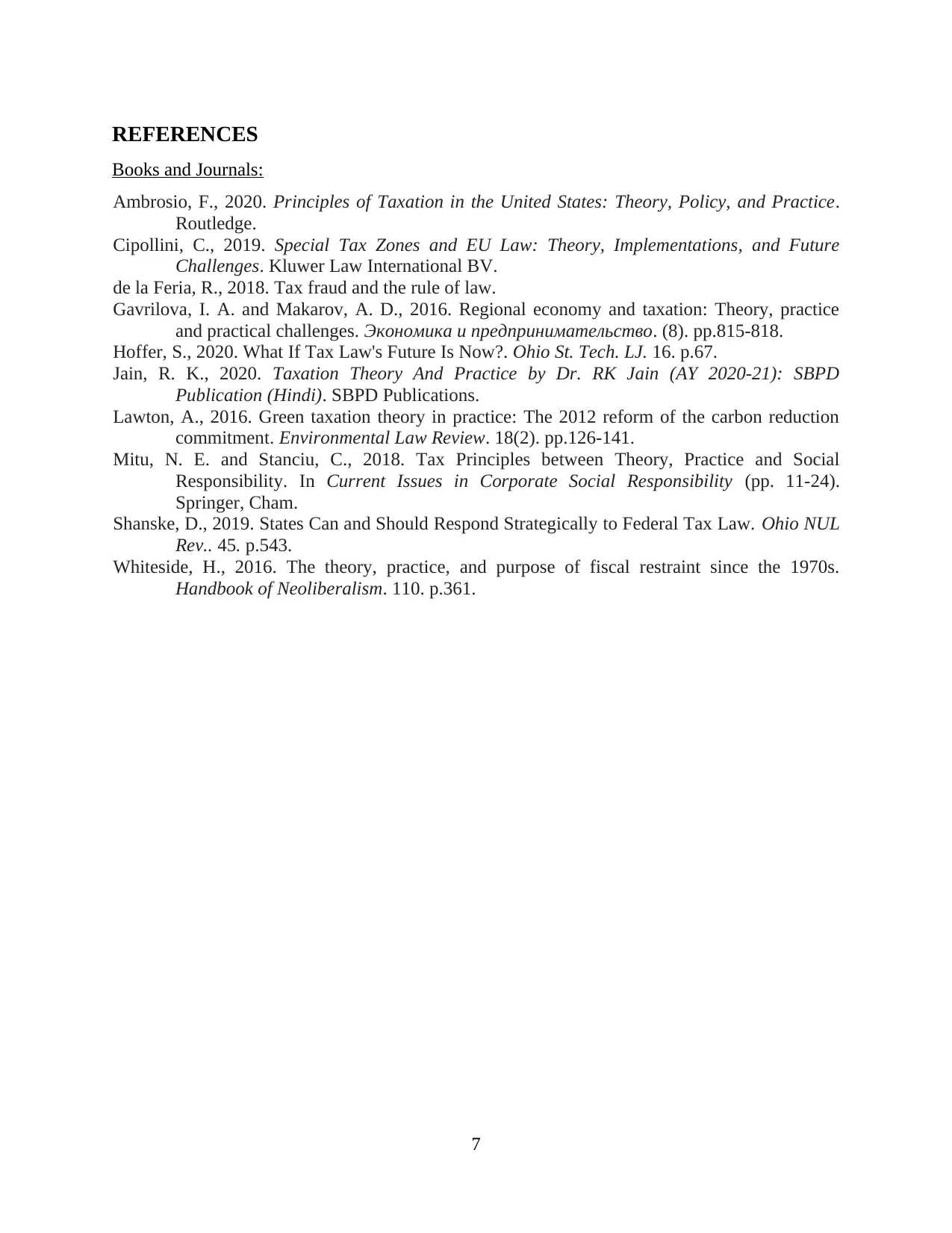
REFERENCES
Books and Journals:
Ambrosio, F., 2020. Principles of Taxation in the United States: Theory, Policy, and Practice.
Routledge.
Cipollini, C., 2019. Special Tax Zones and EU Law: Theory, Implementations, and Future
Challenges. Kluwer Law International BV.
de la Feria, R., 2018. Tax fraud and the rule of law.
Gavrilova, I. A. and Makarov, A. D., 2016. Regional economy and taxation: Theory, practice
and practical challenges. Экономика и предпринимательство. (8). pp.815-818.
Hoffer, S., 2020. What If Tax Law's Future Is Now?. Ohio St. Tech. LJ. 16. p.67.
Jain, R. K., 2020. Taxation Theory And Practice by Dr. RK Jain (AY 2020-21): SBPD
Publication (Hindi). SBPD Publications.
Lawton, A., 2016. Green taxation theory in practice: The 2012 reform of the carbon reduction
commitment. Environmental Law Review. 18(2). pp.126-141.
Mitu, N. E. and Stanciu, C., 2018. Tax Principles between Theory, Practice and Social
Responsibility. In Current Issues in Corporate Social Responsibility (pp. 11-24).
Springer, Cham.
Shanske, D., 2019. States Can and Should Respond Strategically to Federal Tax Law. Ohio NUL
Rev.. 45. p.543.
Whiteside, H., 2016. The theory, practice, and purpose of fiscal restraint since the 1970s.
Handbook of Neoliberalism. 110. p.361.
7
Books and Journals:
Ambrosio, F., 2020. Principles of Taxation in the United States: Theory, Policy, and Practice.
Routledge.
Cipollini, C., 2019. Special Tax Zones and EU Law: Theory, Implementations, and Future
Challenges. Kluwer Law International BV.
de la Feria, R., 2018. Tax fraud and the rule of law.
Gavrilova, I. A. and Makarov, A. D., 2016. Regional economy and taxation: Theory, practice
and practical challenges. Экономика и предпринимательство. (8). pp.815-818.
Hoffer, S., 2020. What If Tax Law's Future Is Now?. Ohio St. Tech. LJ. 16. p.67.
Jain, R. K., 2020. Taxation Theory And Practice by Dr. RK Jain (AY 2020-21): SBPD
Publication (Hindi). SBPD Publications.
Lawton, A., 2016. Green taxation theory in practice: The 2012 reform of the carbon reduction
commitment. Environmental Law Review. 18(2). pp.126-141.
Mitu, N. E. and Stanciu, C., 2018. Tax Principles between Theory, Practice and Social
Responsibility. In Current Issues in Corporate Social Responsibility (pp. 11-24).
Springer, Cham.
Shanske, D., 2019. States Can and Should Respond Strategically to Federal Tax Law. Ohio NUL
Rev.. 45. p.543.
Whiteside, H., 2016. The theory, practice, and purpose of fiscal restraint since the 1970s.
Handbook of Neoliberalism. 110. p.361.
7
⊘ This is a preview!⊘
Do you want full access?
Subscribe today to unlock all pages.

Trusted by 1+ million students worldwide
1 out of 9
Related Documents
Your All-in-One AI-Powered Toolkit for Academic Success.
+13062052269
info@desklib.com
Available 24*7 on WhatsApp / Email
![[object Object]](/_next/static/media/star-bottom.7253800d.svg)
Unlock your academic potential
Copyright © 2020–2025 A2Z Services. All Rights Reserved. Developed and managed by ZUCOL.





